How to Deadhead Zinnias: The Ultimate Guide for More Blooms
Today, I want to talk to you about a simple yet incredibly effective technique that can transform your garden beds into a burst of color and beauty.
We’ll dive into the world of zinnias and explore why deadheading zinnias is a game-changer for your garden.
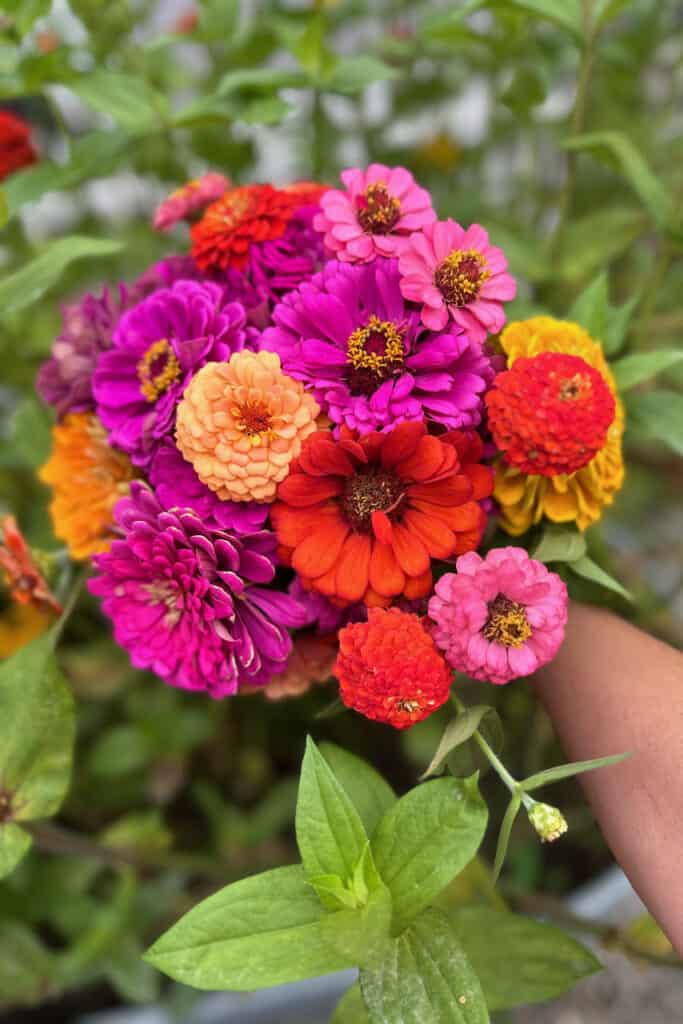
With their bright colors and charming blooms, zinnias have a special place in the garden.
But did you know that deadheading, the act of removing spent flowers, can take your zinnia garden to the next level?
In this guide, we’ll uncover the secrets behind deadheading and how it can result in more zinnia blossoms and an extended blooming season.

Understanding Zinnias
Before we get our hands dirty, let’s get to know the star of the show—zinnias! These lovely annual plants, belonging to the Asteraceae family, come in various shapes, sizes, and vibrant colors.
Whether you prefer the classic daisy-like zinnias or an elegant variety, there are zinnias for everyone’s taste.
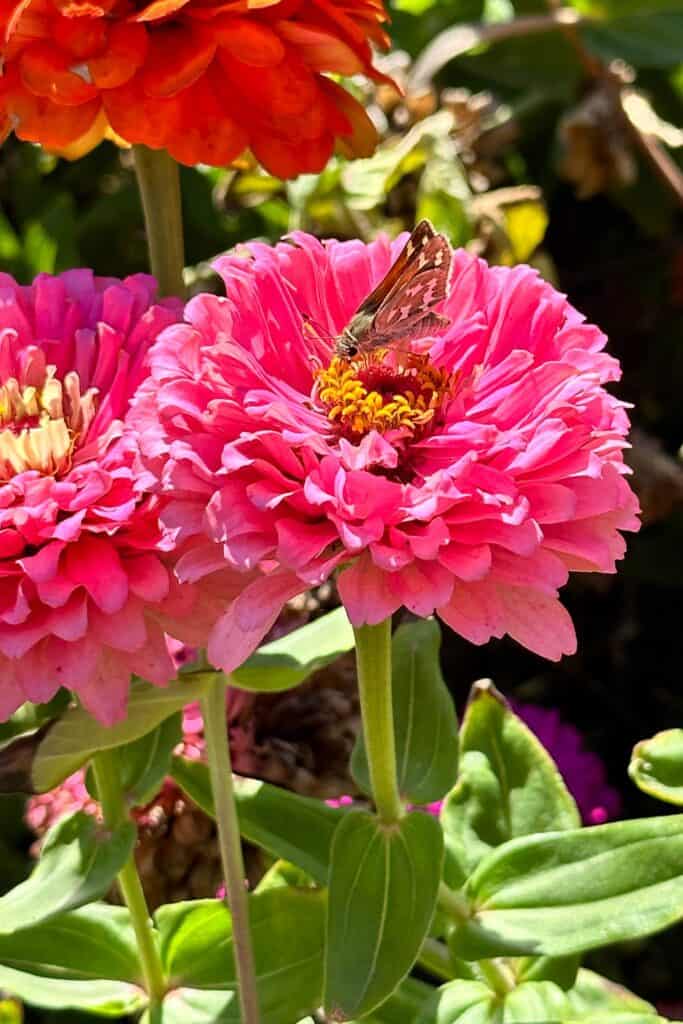
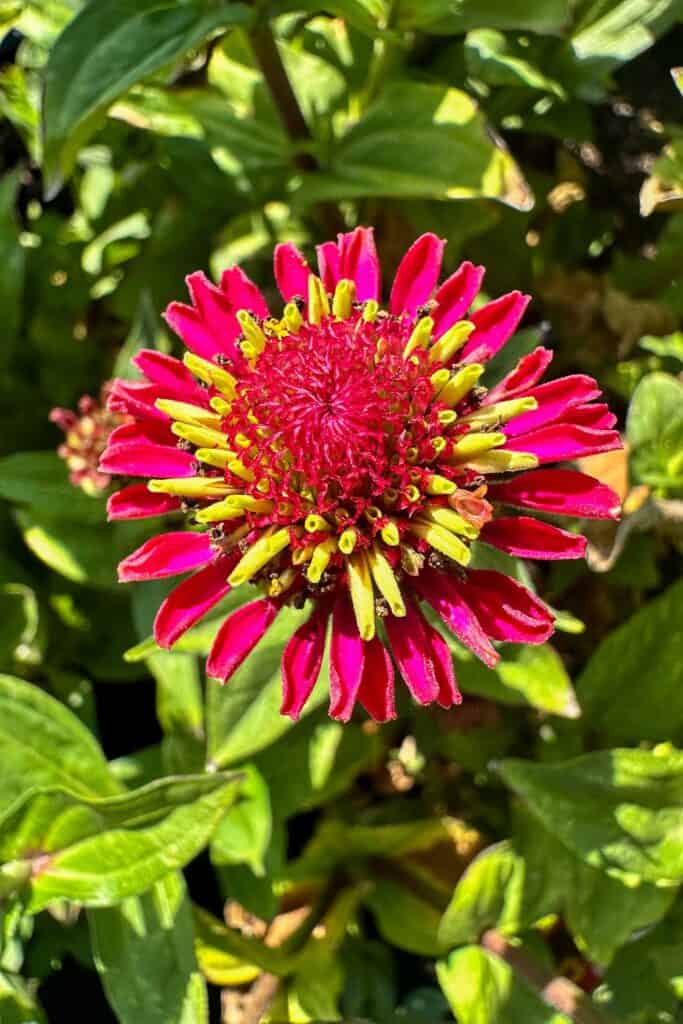
Their ease to grow make them a popular choice among gardeners.
Their colorful blooms also make excellent cut flowers.

On my blog WM Design House, I may sometimes use affiliate links, which means a small commission is earned if you purchase via the link. The price will be the same whether you use the affiliate link or go directly to the vendor’s website using a non-affiliate link.
Plant zinnia seeds in your cutting garden and follow proper maintenance, including the deadheading process detailed below, to create a steady supply of fresh flowers to use in arrangements in your home all season long.

What is Deadheading?
The term deadheading may sound a bit grim, but in gardening, it’s all about promoting life and beauty.
Essentially, it means removing the faded or spent flowers from your zinnias.
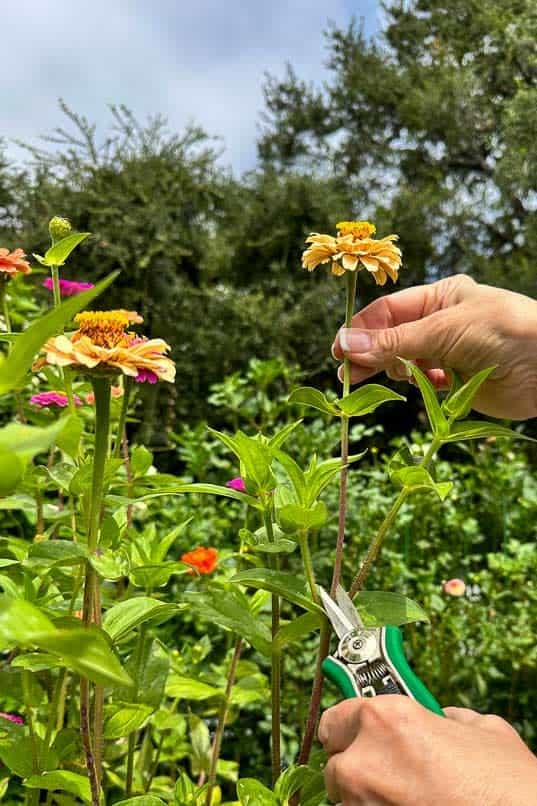
Why is this a good idea? The science behind deadheading is fascinating – it redirects the plant’s energy away from producing seeds and towards creating new flowers. This simple act stimulates continuous new growth and flowering.
With proper deadheading, your zinnia blooming season can extend through early summer, well into fall.

Tools and Materials
Before we start snipping away at your zinnia flower heads, you’ll need a few essentials:
- A pair of sharp shears, pruners, or scissors.
- Gloves to protect your hands.
- A container to collect dead blooms.
With these in hand, you’ll be ready to start.
When to Deadhead Zinnia Flowers
Timing is everything when it comes to deadheading. To maximize the benefits, it’s essential to remove spent blooms regularly throughout the growing season. Identifying the best time to deadhead is a skill every gardener should know, whether you are a gardening expert or a beginner.
But how do you spot the ones that need to go? To identify old flowers in need of deadheading, look for blooms that have noticeably wilted, turned brown, or developed a papery texture.
These are signs that zinnia blooms have completed their life cycle and are ready to be removed. Remember, the goal is to snip away these faded blooms before they have a chance to go to seed.
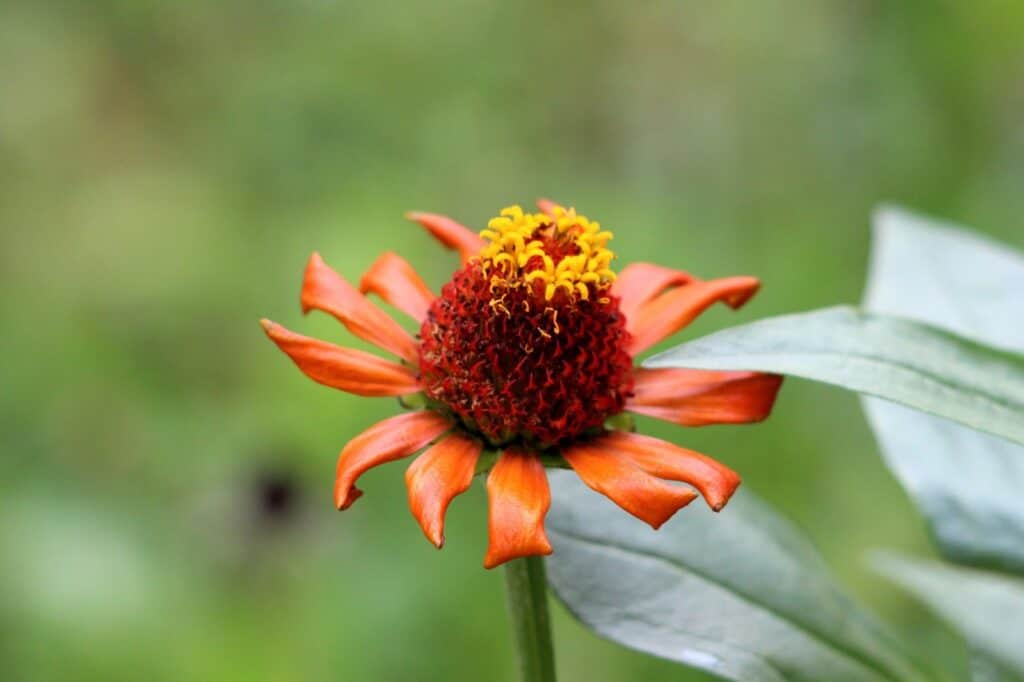
How to Deadhead Zinnias Step by Step
Deadheading zinnias is a straightforward process that anyone can master, even beginner gardeners. Follow this step-by-step guide to ensure your zinnias keep blooming beautifully.
- Observe the Zinnia Plant: Look over your zinnia plant, and inspect the blooms.
- Identify Spent or Faded Flowers: Examine the zinnia carefully and look for flowers that have faded or withered. These are the ones that need to go.
- Position Your Pruning Tool Correctly: Ensure your pruners or scissors are clean and sharp, and hold them firmly.
- Make Clean Cuts: To encourage new growth, make a clean cut just above a set of leaves or a branching point. This strategic cut tells the plant to redirect its energy towards producing fresh blooms.
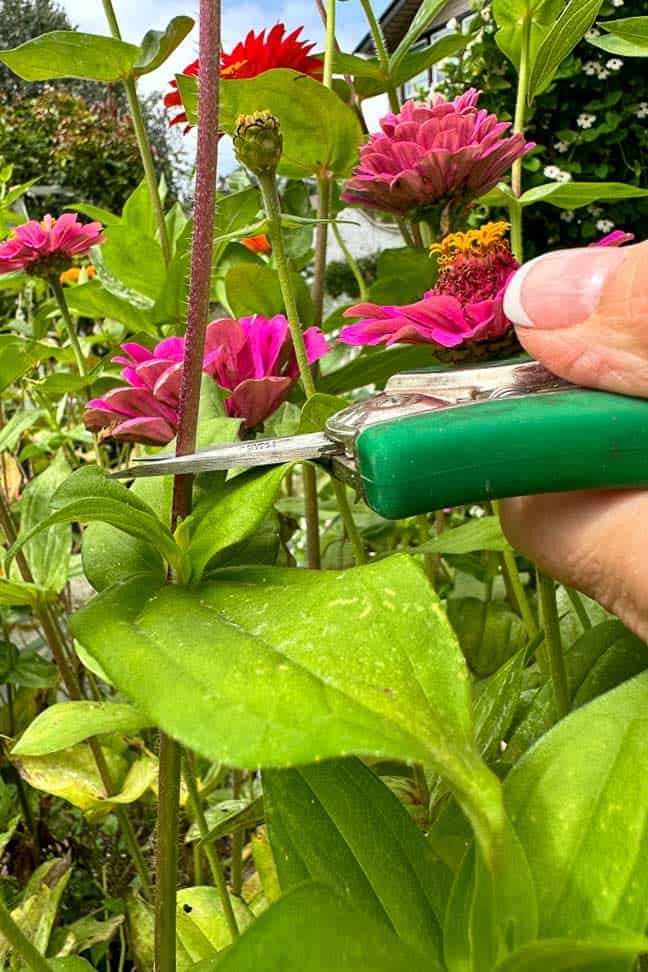
- Collect and Dispose of Removed Blooms Properly: Remember to collect the removed blooms in your container. Proper disposal prevents the spread of diseases and pests, keeping your garden healthy.
Tips for Successful Deadheading
While deadheading is a relatively straightforward task, some tips and tricks can elevate your zinnia garden even further:
Avoid Cutting Too Close to the Stem: Ensure you leave a small portion of the stem intact when deadheading. Cutting too close to the main stem can harm the plant.
Keep Your Tools Clean and Sharp: Regularly clean and sharpen your pruning tools to make precise cuts without damaging the plant.
Wear Gloves to Protect Your Hands: Zinnias do not tend to have prickly stems, but wearing gloves will protect your hands and prevent soil and debris from getting on your skin.
Deadhead Regularly: Make deadheading a regular part of your gardening routine throughout the growing season. The more diligent you are, the more abundant the blooms will be.
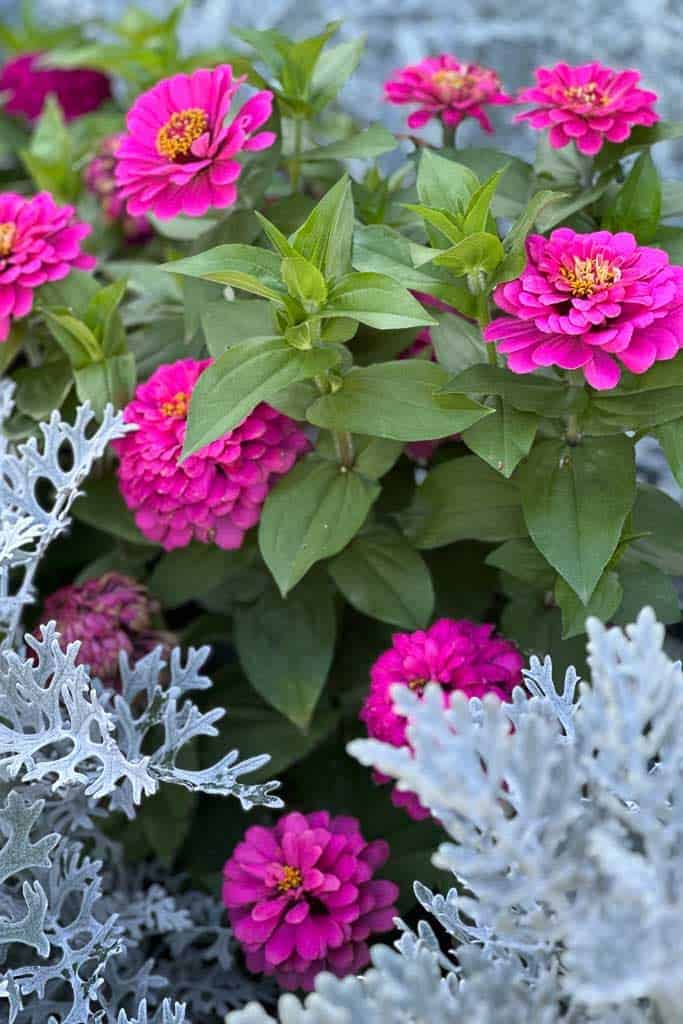
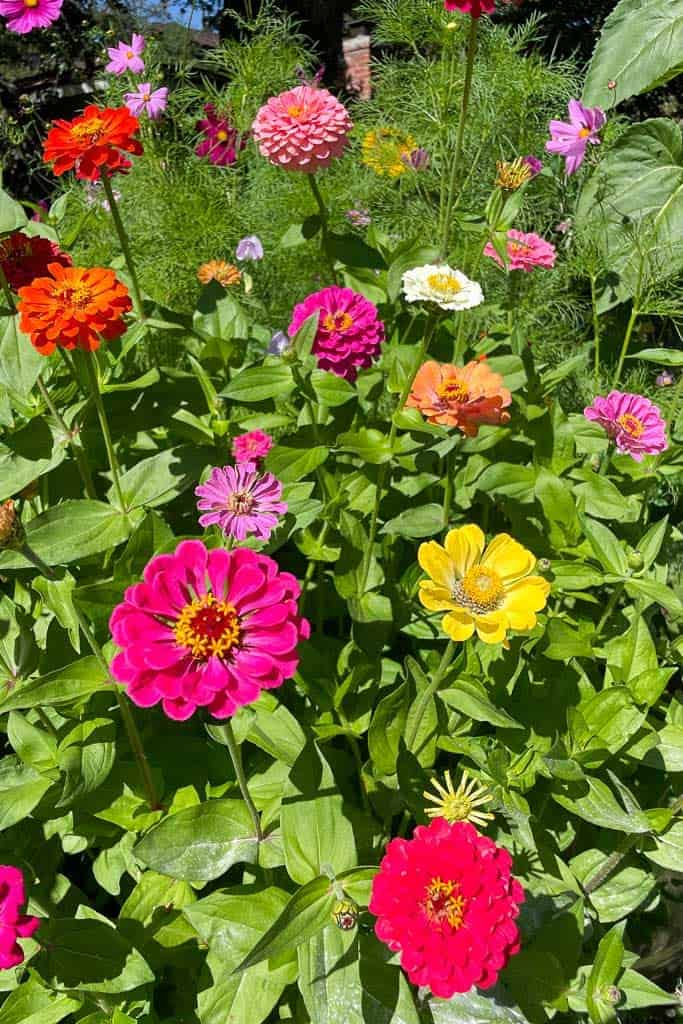
Common Mistakes to Avoid
Even the most seasoned gardeners can make errors when deadheading zinnias. By recognizing and avoiding these common pitfalls, you’ll ensure your zinnias remain healthy and vibrant.
Overlooking Spent Flowers: Failing to deadhead regularly or overlooking dead flowers can result in zinnias channeling their energy into seed production, leading to fewer blossoms.
Improper Cutting Technique: Another common deadheading mistake is using improper techniques. Cutting too close to the main stem can slow new growth and potentially harm the plant.
Maintaining Healthy Zinnia Plants
While deadheading plays a crucial role in zinnia care, it’s also essential to consider the overall well-being of these annual flowers. Luckily, zinnias are one of the easiest flowers to care for in your garden. Here are some simple tips for growing a healthy zinnia plant.
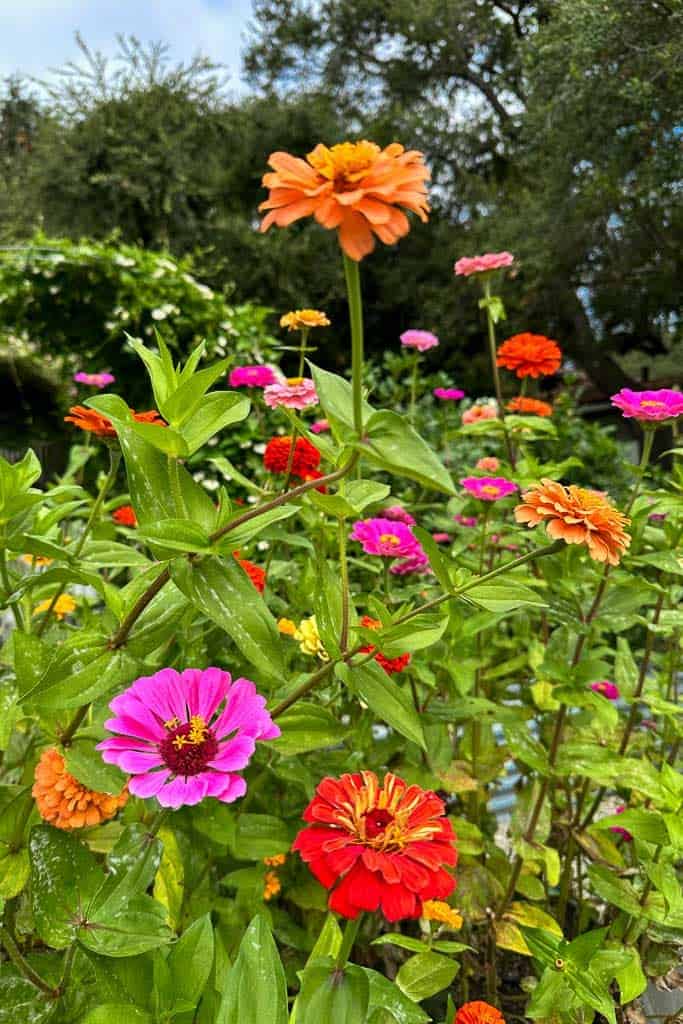
Spacing and Preparation:
When planting zinnias, space plants appropriately to reduce overcrowding. They thrive in full sun and fertile, well-drained soil. Before planting seeds or young plants, loosen the dirt to a depth of about 6-8 inches and mix in organic matter. This preparation will create an ideal environment for zinnia roots to establish and grow.

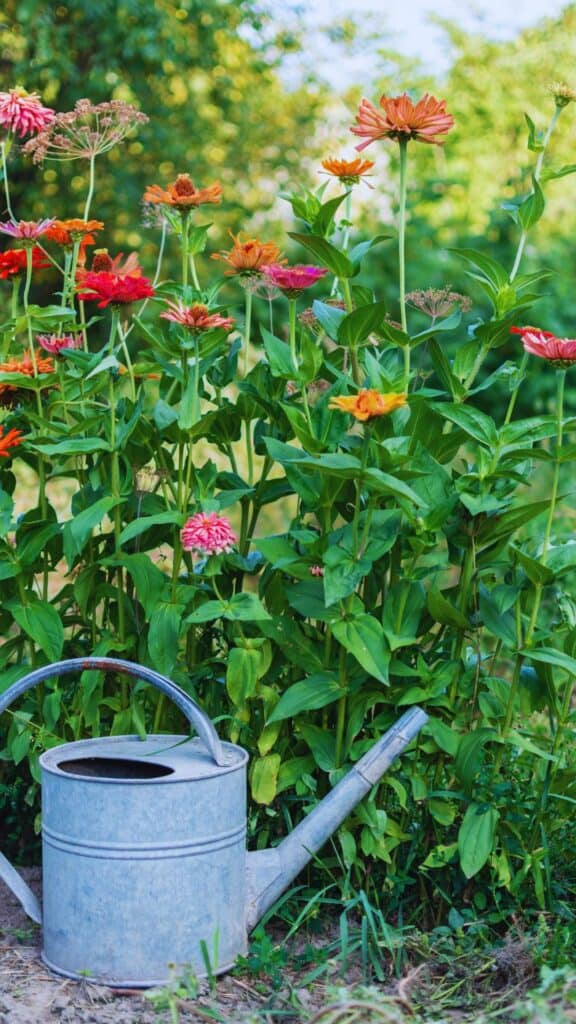
Watering:
Zinnias prefer consistently moist soil. Water them regularly, especially during dry spells, but be cautious not to overwater, which can lead to root rot. Aim to water at the base of the plant to keep the leaves dry and prevent disease.
Fertilizing:
Use a balanced, all-purpose fertilizer to provide essential nutrients to your zinnias. Apply it according to the package instructions, typically every 4-6 weeks during the growing season.
Mulching:
Applying a layer of mulch around the base of your zinnias helps retain moisture, regulate soil temperature, and keep weeds at bay. Organic mulch. like straw or compost, is a great option.
Pest and Disease Management:
Keep an eye out for common garden pests like aphids and fungal diseases like powdery mildew. Use appropriate insecticides or fungicides if necessary, but aim for environmentally friendly options to minimize harm to beneficial insects.
Pruning:
Besides deadheading, occasional pruning can help maintain zinnia health. Trim back leggy or crowded growth to provide good air circulation and prevent disease.
By following these care guidelines, you’ll maintain healthy zinnia plants that not only survive but thrive, gracing your flower beds with a dazzling display of colorful flowers and beautiful blooms.
FAQs about Deadheading Zinnias
Now, let’s address some common questions:
Should I cut off dead zinnia flowers?
Absolutely! Remove dead flowers promptly to encourage new blooms. This practice redirects the plant’s energy from seed production to creating more flower buds.
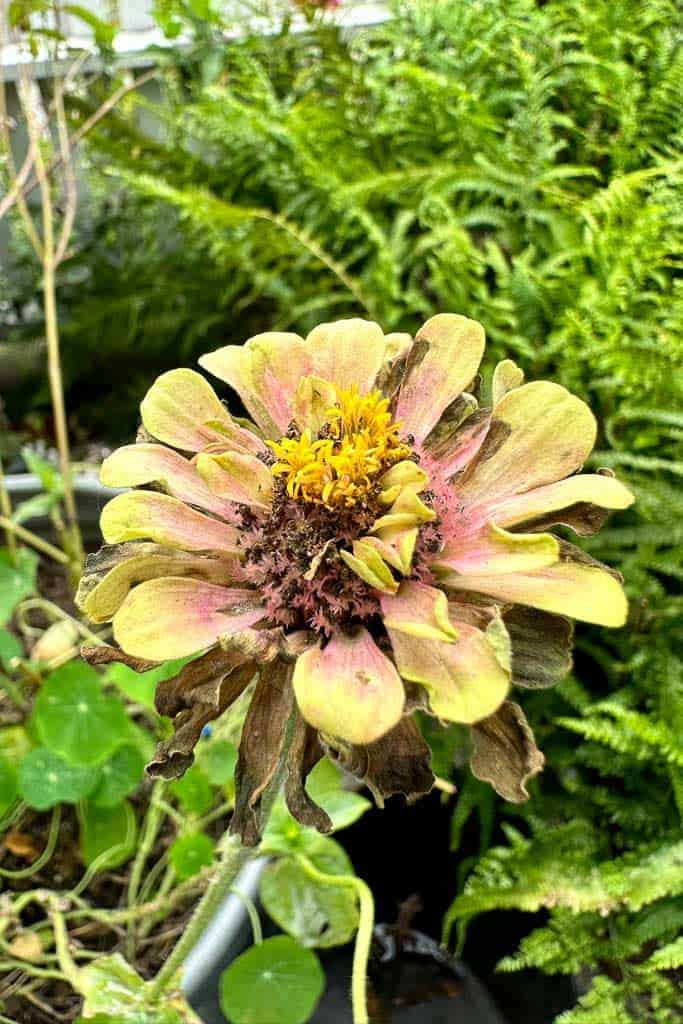
What happens if you don’t deadhead zinnias?
If you skip deadheading, zinnias will focus their energy on producing seeds rather than new flowers. This can result in fewer blooms and a shorter blooming season.
How do you cut zinnias to rebloom?
To encourage zinnias to rebloom, use clean, sharp pruning shears or scissors to cut just above a set of leaves or a branching point. This helps the plant direct its energy into producing new flowers.

How often do you deadhead zinnias?
Deadhead zinnias regularly throughout the growing season, as soon as you notice faded or spent flowers. The more diligent you are, the more plentiful your zinnias will be.
Deadheading zinnias is a simple and immensely rewarding practice that can transform your garden into a spectacular show of color and life. Removing spent flowers sends a signal to your zinnias to keep producing blooms, resulting in a beautiful and continuously blooming garden. So, now that you know all the best tips and tricks don’t hesitate to try deadheading zinnias in your garden. Then, watch the magic unfold as your zinnias flourish.



For more information, check out these related blog posts:
Are Zinnias Perennials? How To Grow Beautiful Zinnias

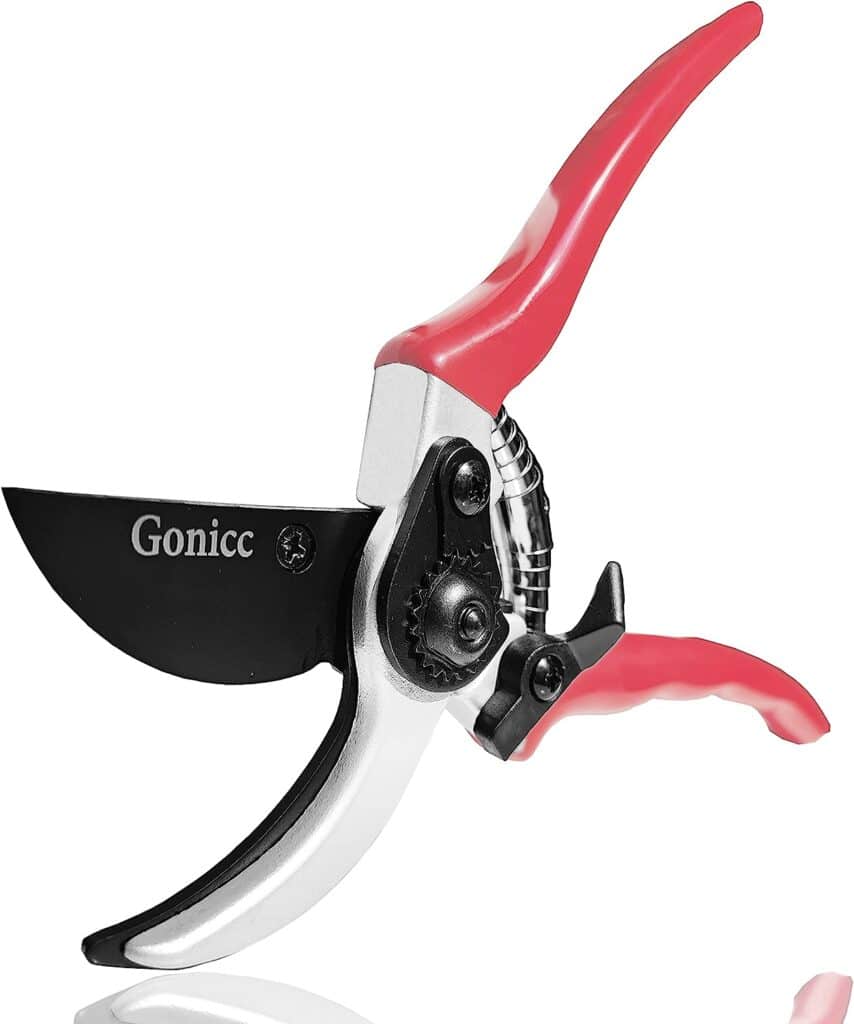
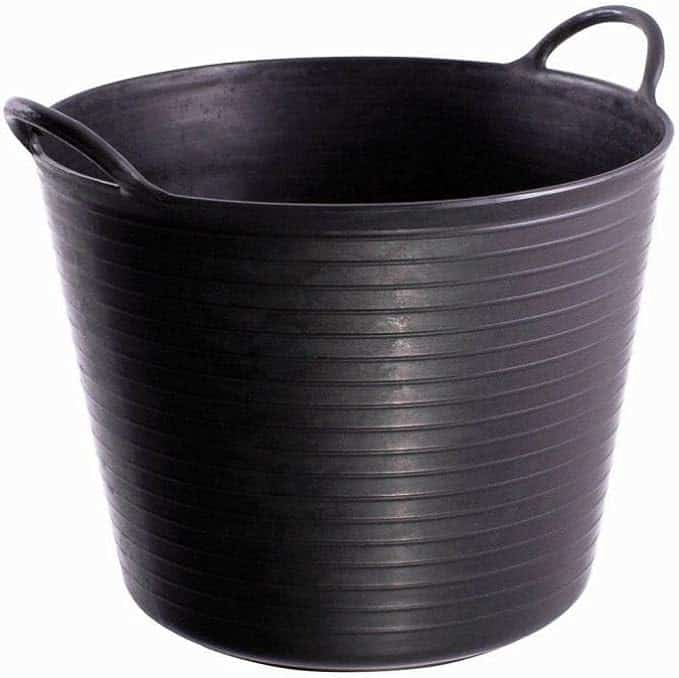


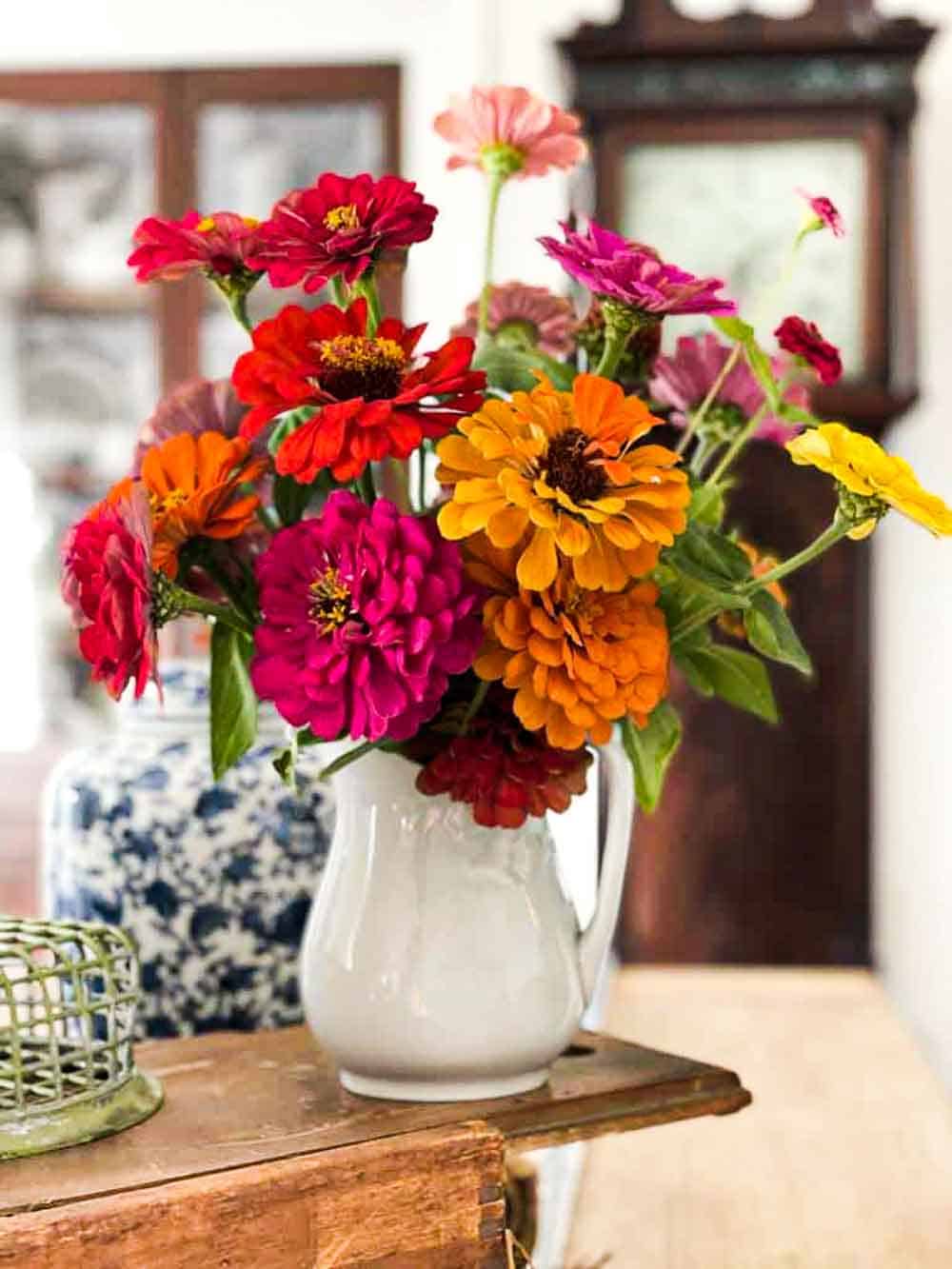
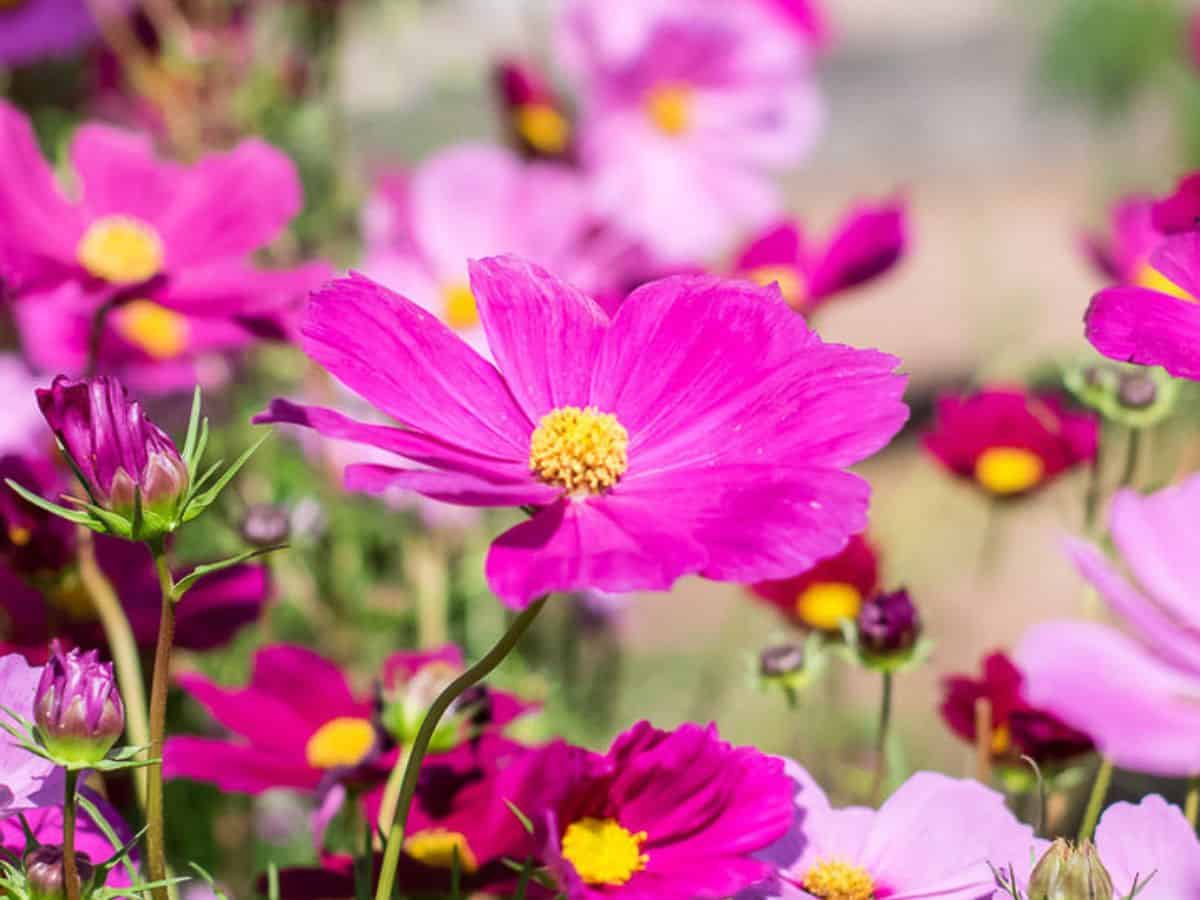

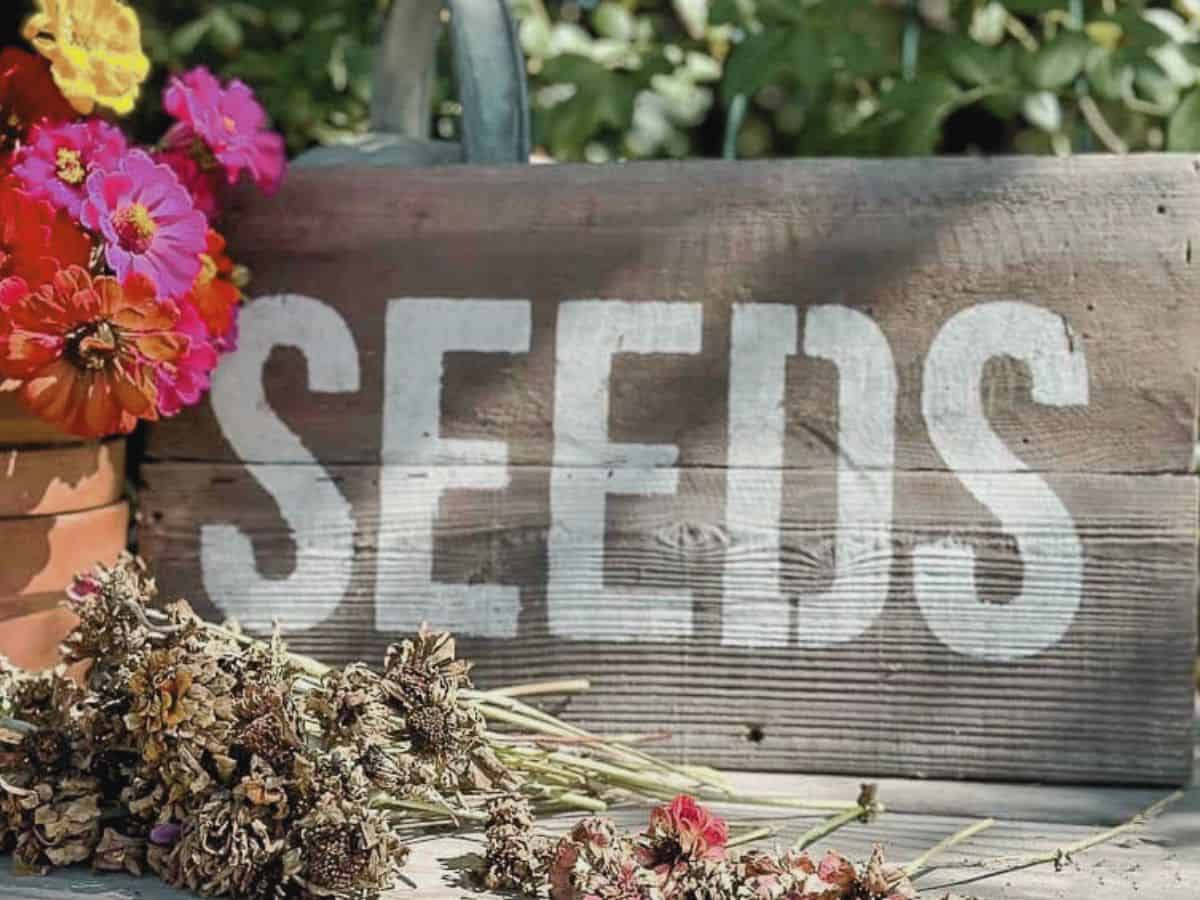
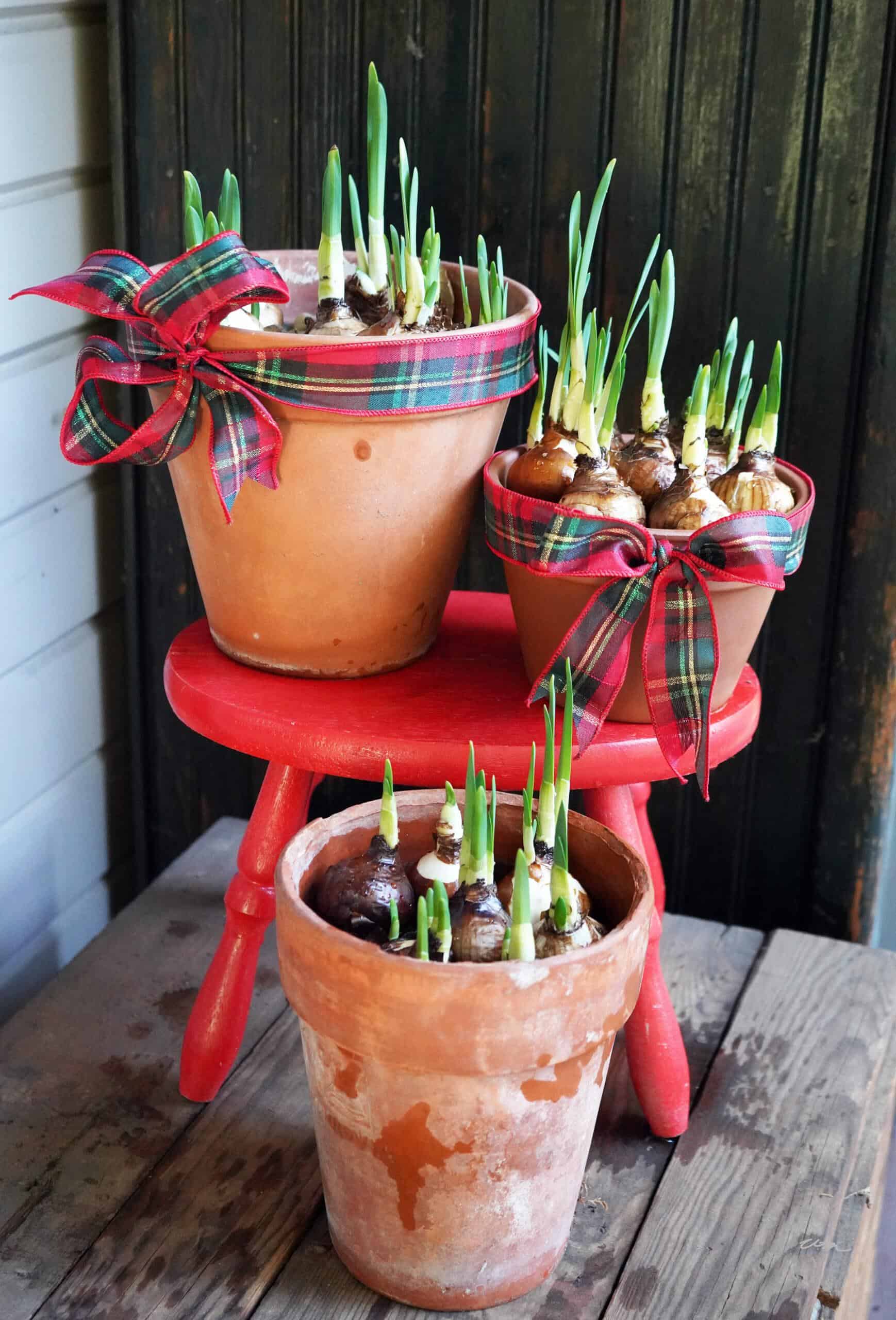
Love this post! Deadheading zinnias has never been easier. Can’t wait to try these tips and increase my blooms. 💜
Thank you! Happy gardening.
Hi Wendy! I love your posts about gardening the most. You always have great photos to accompany your text. (Case in point – a spent Zinnia needing deadheading). I have planted Zinnias from seed for the last couple of years. They are so easy to grow and bring such joy. I love them. Thanks for all the tips with dead heading and for growing them successfully.
Thank you Anna, you are so sweet. I have such a love for gardening, especially flowers.
Unfortunately, I got struck with powdery mildew this year and have had difficulty getting rid of it.
I am sure you have enjoyed your zinnias this season. They truly are so easy to grow.
Thanks for all of the tips. I love Zinnias!!!
Thank you Susan.